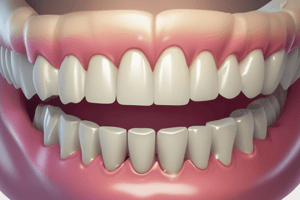Podcast
Questions and Answers
What is the primary concern when preparing cavities for restoratives?
What is the primary concern when preparing cavities for restoratives?
Esthetics
What type of restorative materials are preferred for cavities?
What type of restorative materials are preferred for cavities?
Tooth-color materials
What should the dentist have before starting cavity preparation?
What should the dentist have before starting cavity preparation?
A pre-determined mental picture for the correct cavity design
What is the purpose of depth cutting in cavity preparation?
What is the purpose of depth cutting in cavity preparation?
What is the recommended initial cavity depth from the tooth surface to the pulpal wall?
What is the recommended initial cavity depth from the tooth surface to the pulpal wall?
What is the purpose of lateral cutting in cavity preparation?
What is the purpose of lateral cutting in cavity preparation?
How should the lateral extensions be made during cavity preparation?
How should the lateral extensions be made during cavity preparation?
What is the characteristic of the axial walls in cavity preparation?
What is the characteristic of the axial walls in cavity preparation?
What type of cavities start at the proximal surfaces of posterior teeth?
What type of cavities start at the proximal surfaces of posterior teeth?
What is the recommended bur size for depth cutting in cavity preparation?
What is the recommended bur size for depth cutting in cavity preparation?
Flashcards are hidden until you start studying
Study Notes
Cavity Preparation Fundamentals
- The design of cavity preparation determines stress distribution, stress absorption, and retention against pull of sticky displacement.
- It also determines the safety-dependent biocompatibility of surgical procedures, including the area-dependent sensitivity of exposed fresh dentin.
Aesthetic Considerations
- Cavity outlines have a significant effect on the esthetic appearance of restored, especially anterior, teeth.
- Refined, smooth, symmetrical, and defect-free cavity margins contribute to the esthetic appearance of restorations.
- Preservation of undermined labial enamel, maintaining a tooth-to-tooth interproximal contact angle, and precluding through-through class III preparations contribute to better cosmetic appearance of restored anterior teeth.
Cavity Design
- Cavity preparations should satisfy inter-related mechanical, biological, and esthetic fundamentals.
- The design of external outlines and dimensions, and internal geometry should be conservative and compatible with the inherent characteristics of the restorative system and oral environmental factors.
Clinical Steps of Cavity Preparation
- Gaining access to the lesion aims at complete exposure of the carious lesion while limiting all cut.
- Anchoring the auxiliary portions to the tooth independently from the principal portion reduces the build-up of tensile stresses at the isthmus areas.
Retention Means
- Macro-mechanical undercuts, retentive grooves, dentin coves, gingival slots, and axial skirts are common retentive means.
- Micromechanical attachment can be attained through resin bonding systems and cements that utilize frictional walls retention.
- Chemical adhesion can be attained with glass ionomer cements and 10-MDP containing adhesive systems.
Principles of Cavity Preparation
- Black's procedural steps include: establishing the outline form, obtaining the resistance and retention form, removing residual caries, developing the convenience form, planing of enamel walls, and debridement, cleansing, and disinfecting the preparation.
Establishing the Outline Form
- The outline form describes the external boundary of the complete preparation, including its shape and surface area.
- It involves simultaneous gaining access to the pathology, with depth cutting into dentin, and lateral extensions of cavity walls into predetermined outlines.
Procedural Steps
- Depth cutting is attained using a round-end cylindrical carbide bur # 245 at high speed.
- Lateral cutting is continued along pits and fissures to establish a homogeneous outline form of smooth, sweeping curves.
Studying That Suits You
Use AI to generate personalized quizzes and flashcards to suit your learning preferences.




